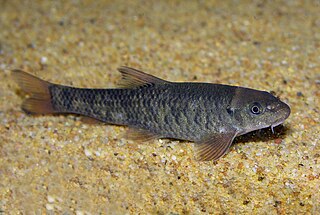
Barbus is a genus of ray-finned fish in the family Cyprinidae. The type species of Barbus is the common barbel, first described as Cyprinus barbus and now named Barbus barbus. Barbus is the namesake genus of the subfamily Barbinae, but given their relationships, that taxon is better included in the Cyprininae at least for the largest part.

Alburnoides is a genus of cyprinid fishes native to Europe and Asia. Many species are known as riffle minnows or spirlins.

Alburnus is a genus of fish in the family Cyprinidae, the carps and minnows. They are known commonly as bleaks. A group of species in the genus is known as shemayas. The genus occurs in the western Palearctic realm, and the center of diversity is in Turkey.

Capoeta, also known as scrapers, is a genus of fish in the family Cyprinidae found in Western Asia. The distribution extends from Turkey to the Levant, to Transcaucasia, Iraq, Turkmenistan, in Armenia, particularly in lake Sevan and northern Afghanistan. This genus is most closely related to Luciobarbus and in itself is divided into three morphologically, biogeographically and genetically distinct groups or clades: the Mesopotamian clade, the Anatolian-Iranian clade and the Aralo-Caspian clade.

Cobitis is a genus of small freshwater fish in the family Cobitidae from temperate and subtropical Eurasia. It contains the "typical spiny loaches", including the well-known spined loach of Europe. Similar spiny loaches, occurring generally south of the range of Cobitis, are nowadays separated in Sabanejewia.

Garra is a genus of fish in the family Cyprinidae. These fish are one example of the "log suckers", sucker-mouthed barbs and other cyprinids commonly kept in aquaria to keep down algae. The doctor fish of Anatolia and the Middle East belongs in this genus. The majority of the more than 140 species of garras are native to Asia, but about one-fifth of the species are from Africa.

Gobio is a genus of typical gudgeons, ray-finned fish in the family Cyprinidae many of which are endemics of south-eastern Europe. Members of the genus are usually small fish, rarely longer than 10 cm.
Squalius is a genus of fish in the family Cyprinidae found in Europe and Asia. Hybridization is not rare in the Cyprinidae, including this genus. S. alburnoides is known to be of ancient hybrid origin, with the paternal lineage deriving from a prehistoric species related to Anaecypris; the latter mated with ancestral S. pyrenaicus. Present-day S. alburnoides mates with sympatric congeners of other species.
Luciobarbus is a genus of ray-finned fishes in the family Cyprinidae. Its members are found in fresh and brackish waters of southern Europe, northern Africa, the wider Near East, the Aral and Caspian Seas, and rivers associated with these. Several species in the genus are threatened. Most species are fairly small to medium-sized cyprinids, but the genus also includes several members that can surpass 1 m (3.3 ft) in length and the largest, the mangar can reach 2.3 m (7.5 ft).
Alburnus doriae is a species of cyprinid fish from Iran. It was previously thought to be restricted to central Iran, but recent research shows that it is more widespread and that Alburnus amirkabiri and Petroleuciscus esfahani are probably synonyms of Alburnus doriae.

Ponticola is a genus of gobies native mostly to fresh waters of the Black Sea - Caspian Sea region in Eurasia. Some species occur in the brackish-water Black and Caspian seas themselves. It was considered to be part of the broader goby subfamily Benthophilinae, also endemic to the same region, although the 5th edition of Fishes of the World does not list any subfamilies in the Gobiidae. Originally, Ponticola was described as subgenus of Neogobius.
Alburnoides namaki, is a fish species of the family Cyprinidae, known from Iran. It can be differentiated from its cogenerates by differences in fin ray and vertebral counts, together with other morphological characters.
Alburnoides nicolausi, is a fish species of the family Cyprinidae, known from Iran. I can be differentiated from its cogenerates by differences in fin ray and vertebral counts, together with other morphological characters.
Alburnoides idignensis, is a fish species of the family Cyprinidae endemic to Iran. It can be differentiated from its cogenerates by differences in fin ray and vertebral counts, together with other morphological characters. The specific name is derived from the Sumerian name for the River Tigris, "Idigna".
Alburnoides varentsovi is a fish species of the family Cyprinidae, known from Turkmenistan. It can be differentiated from its cogenerates by differences in fin ray and vertebral counts, together with other morphological characters.
Capoeta gracilis is a species of fish in the family Cyprinidae found in Western Asia. It is part of the large-scaled Capoeta capoeta clade or complex of species in the genus Capoeta.
Samii's riffle minnow is a species of freshwater fish in the family Cyprinidae. It is endemic to the Sefidroud River drainage in Iran.
Capoeta alborzensis is a species of cyprinid in the genus Capoeta.
Capoeta ferdowsii is a species of cyprinid in the genus Capoeta, native the Zohreh and Fahlian rivers in Iran. It is named after Persian poet Ferdowsi.
Capoeta pyragyi is a species of cyprinid in the genus Capoeta. It lives in the Tireh and Sezar rivers of Iran, and it is named after Turkmen poet and spiritual leader Magtymguly Pyragy.








